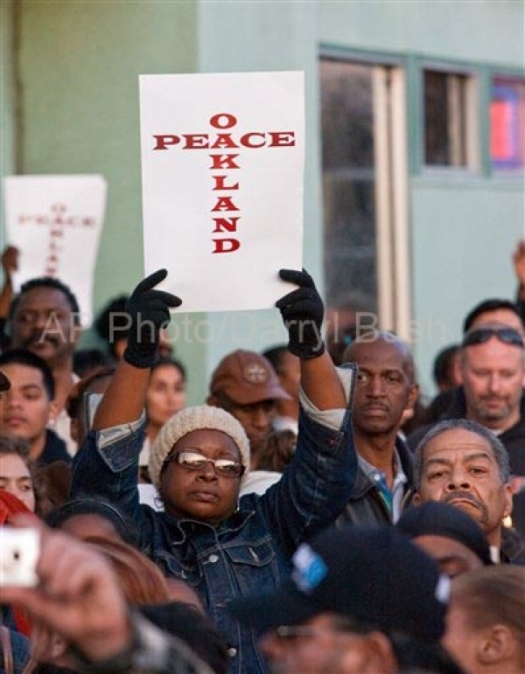
SAN FRANCISCO — The ease with which a convicted felon obtained the assault weapon he allegedly used to murder Oakland police officers points to the challenges of keeping serious firepower off the city’s murder-plagued streets, authorities say.
SAN FRANCISCO — The ease with which a convicted felon obtained the assault weapon he allegedly used to murder Oakland police officers points to the challenges of keeping serious firepower off the city’s murder-plagued streets, authorities say. In the state with some of the nation’s strictest gun laws, 26-year-old parolee Lovelle Mixon was barely out of prison when he died in a shootout with police Saturday that also killed two SWAT team members. Hours earlier, investigators say Mixon gunned down two motorcycle patrolmen during a traffic stop with another gun. Under federal law, convicted felons are prohibited from buying or possessing firearms. This applied to Mixon, who was convicted in 2002 of assault with a firearm during an armed robbery in San Francisco. Oakland police have not disclosed the type of assault weapon they say Mixon used to kill the SWAT officers nor how he obtained the guns. But felons get around the law through burglaries, black market gun traffickers or straw buyers who purchase the weapons legally at gun stores or shows, law enforcement officials said. "It’s unfortunate, but with demand, there’s also supply out there," said Nina Delgadillo, a spokeswoman for the Bureau of Alcohol, Tobacco, Firearms and Explosives. Since the lapse of the federal assault weapons ban in 2004, buyers in California have been going elsewhere to get assault rifles. California law still severely restricts the purchase and possession of assault weapons. But law enforcement agencies say they have their hands full with buyers who obtain the weapons legally in Nevada, which does not have similar restrictions, and bring them back across the state line. Sen. Dianne Feinstein, D-Calif., has said she plans to introduce legislation to bring back the federal assault weapons ban. Feinstein was an author of the 1994 bill, which banned 19 types of semiautomatic, military-style guns. The catalyst for the original measure was the massacre of eight people at a San Francisco law office by a disgruntled ex-client wielding a pair of TEC-9 assault pistols. Feinstein failed to persuade fellow lawmakers in 2004 to extend the ban. California first enacted its ban in 1989 after a mentally unstable drifter with a long criminal record opened fire on a Stockton elementary school yard with a semiautomatic rifle, killing five children. Military-grade weaponry even leaves well-equipped, highly trained SWAT team members vulnerable, experts say. Full-body ballistic shields can stop bullets from the most powerful guns but heavily restrict officers’ movement and vision. Assault weapons can tear right through the soft bulletproof vests most officers wear, said Ed Nowicki, a Chicago police force veteran and director of the International Law Enforcement Educators and Trainers Association. Even heavy body armor capable of stopping assault weapon bullets still leaves the face and neck exposed, he said. Police have declined to say exactly where the Oakland SWAT officers were struck by bullets or what kind of protection they were wearing. "If (the shooter) is in a position where he can conceal himself, where he can wait for officers to expose themselves in the right manner, he could take them out," Nowicki said. It is not unusual that parolee like Mixon would be armed. From October 2007 to October 2008, the ATF referred 403 cases of felons in possession of firearms for federal prosecution in Northern California and Nevada, plus additional cases for state prosecution. But going after felons in possession of weapons is only the first step in stemming the tide of guns on city streets. To stop the flow of guns to felons, officials said the weapons need to be cut off at the source–the trafficker. And building those cases takes time. Informants are one way law enforcement agents learn who is selling guns illegally. Another strategy is gun traces, in which the history of a gun’s ownership is followed from manufacturer to the last legal owner. If investigators can trace guns used in several different crimes back to the same owner, or they notice patterns like one person buying several guns of the same model over a short period of time, trafficking is often suspected. Over the last five years, ATF referred over 10,600 cases and 18,800 defendants for prosecution on suspicion of trafficking more than 336,000 weapons. In one of California’s best known recent cases, Philip Fonsworth-McCorvey of Phoenix, Ariz., pleaded guilty in 2007 to purchasing dozens of guns in Arizona for a San Francisco man who prosecutors said illegally sold them in the Bay Area. Twenty-eight of the 68 guns McCorvey illegally bought were recovered in the Bay Area, most of them at crime scenes, according to the U.S. Attorney’s office in Phoenix, Ariz. "Once a gun finds its way into the illegal market, it never comes back into legal commerce," said Delgadillo of the ATF. ______ In photo: A woman holds a sign saying "Oakland Peace" as the community holds a vigil in Oakland, Calif., on Tuesday March 24, 2009. A large crowd turned out near where two of the officers were shot during a confrontation with armed parole violator Lovelle Mixon on Saturday. The community has been stunned by the loss of life which took the lives of four officers and Mixon.
Copyright 2009 Associated Press. All rights reserved. This material may not be published, broadcast, rewritten, or redistributed.
